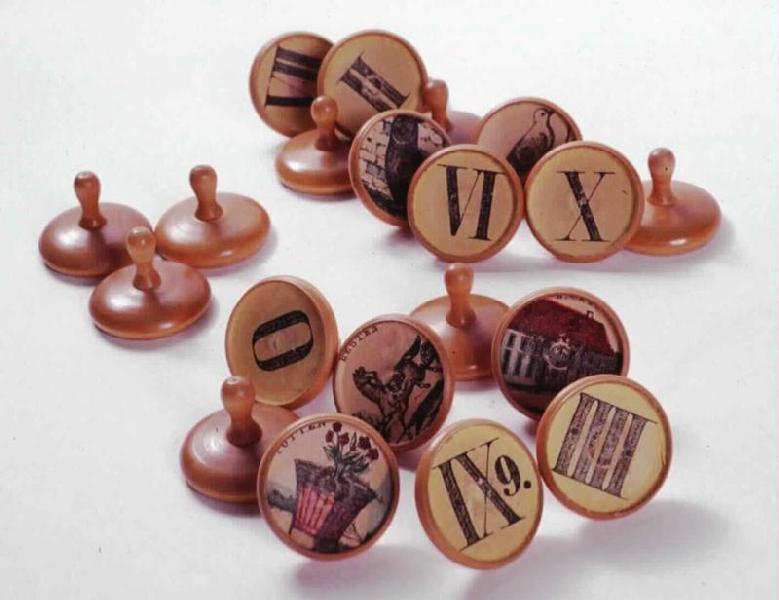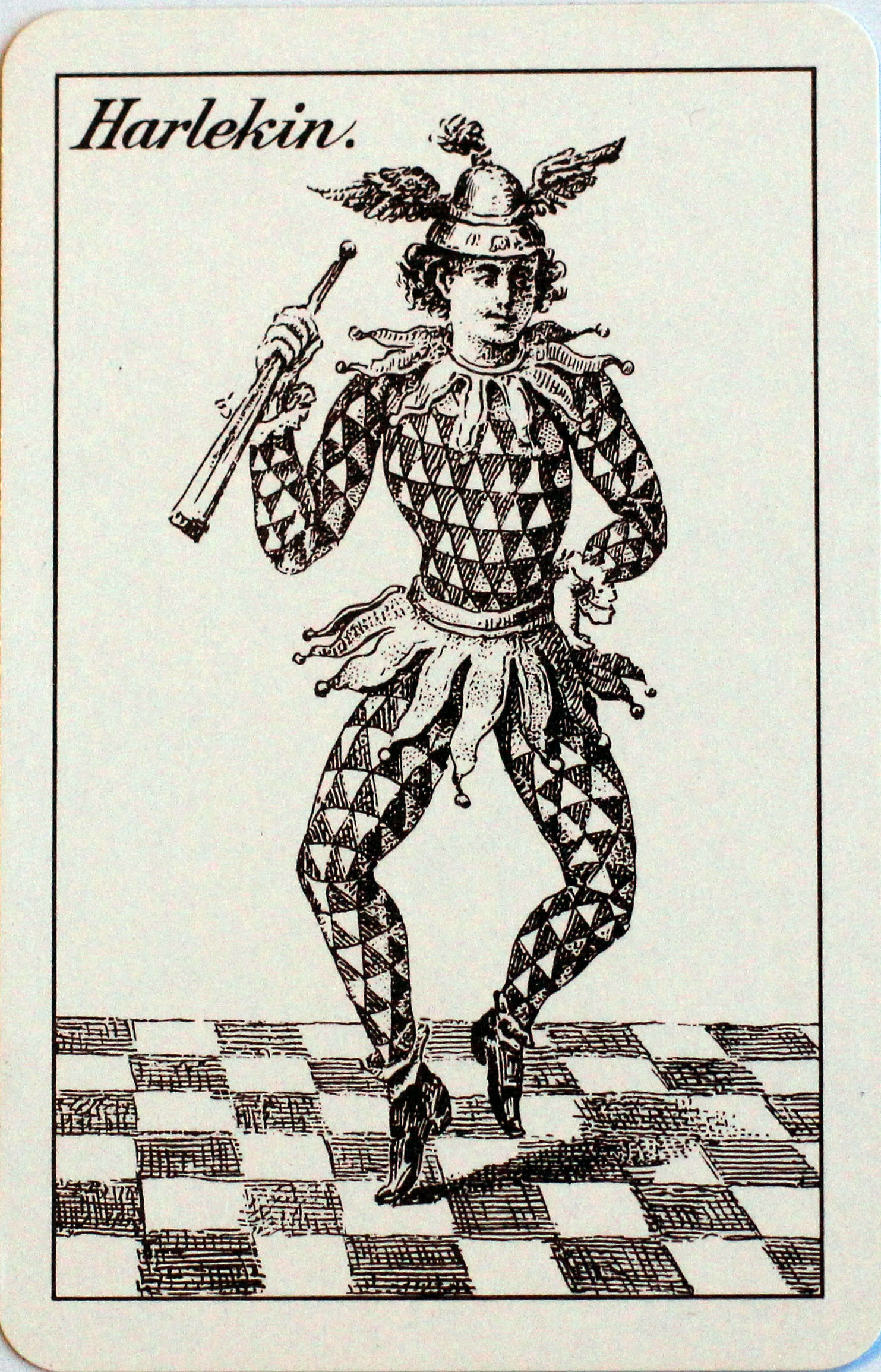|
Gnav
Gnav is a traditional Danish and Norwegian social game that has been played with either special cards or wooden pieces with similar motifs. Gnav packs appeared after 1820 and the game was popular until c. 1920.Jensen (1980), pp. 128–129. The game can be played by 20 or more players, and a minimum of two. Today, only the playing card version is available in Norway. Gnav descends from the 18th century Italian card game of Cuccù, played with bespoke packs, which, in turn is based on a much older French game called Mécontent, the precursor to Coucou. History The origins of Gnav lie in the French children's card game of Mécontent (''Malcontent'' i.e. "unhappy") whose first references date to the early 16th century.Depaulis (1981), pp. 23–24. This game had migrated to Italy by the mid-16th century where it was named "Malcontento" but it was in the early 18th century that the first dedicated decks for what became known as Cuccù (Cuckoo) appeared; the pack consisting of ... [...More Info...] [...Related Items...] OR: [Wikipedia] [Google] [Baidu] |
Cuccù
Cuccù or Cucù ("Cuckoo") is an Italian card game, over 300 years old, that is playable by two to twenty players and which uses a special pack of 40 cards. It is a comparing game in which there is only one winner, and is unusual in that each player only receives one card. History The origins of Cuccù lie in the French card game of '' Mécontent'' (''Malcontent'') whose first references date to the early 16th century. The game, which is still played today, was also known as ''Hère'' but eventually the name ''Coucou'' ("Cuckoo") prevailed. The game migrated to Italy, where the earliest mention of "Malcontento" dates to 1547, but it was in the early 18th century that the first dedicated decks for what became known as ''Cuccù'' (''Cuccù, Cucco, Cucu'' or ''Stu'') appeared; the pack consisting of 38 cards. These special Cuccù packs are the earliest surviving examples of a family of non-suited packs, sometimes referred to as the Cambio family. They originally had 38 cards divi ... [...More Info...] [...Related Items...] OR: [Wikipedia] [Google] [Baidu] |
Dedicated Deck Card Game
A dedicated deck card game is one played with a deck specific to that game, rather than a pack of standard playing cards. Educational packs of cards were being printed by the late eighteenth century, initially designed merely to inform, but later becoming playable games. Modern card games are often sold with non-standard distributions of suits and ranks. Unranked cards By the late eighteenth century, educational packs of cards were being printed without suits or ranks, such as ''The Elements of Astronomy and Geography Explained'', published by John Wallis in 1795. These served as teaching aids rather than being playable games. Charles Hodges' 1828 game ''Astrophilogeon'' was a deck of 60 cards showing 30 constellations and 30 terrestrial maps, with which players could play a game attempting to obtain corresponding pairs. An early 20th century dedicated deck card game was ''Touring (card game), Touring'', published in 1906, and inspiring ''Mille Bornes'' in 1954. Play typically b ... [...More Info...] [...Related Items...] OR: [Wikipedia] [Google] [Baidu] |
Card Game
A card game is any game that uses playing cards as the primary device with which the game is played, whether the cards are of a traditional design or specifically created for the game (proprietary). Countless card games exist, including families of related games (such as poker). A small number of card games played with traditional decks have formally standardized rules with international tournaments being held, but most are folk games whose rules may vary by region, culture, location or from circle (cards), circle to circle. Traditional card games are played with a ''deck'' or ''pack'' of playing cards which are identical in size and shape. Each card has two sides, the ''face'' and the ''back''. Normally the backs of the cards are indistinguishable. The faces of the cards may all be unique, or there can be duplicates. The composition of a deck is known to each player. In some cases several decks are Shuffling, shuffled together to form a single ''pack'' or ''shoe''. Modern car ... [...More Info...] [...Related Items...] OR: [Wikipedia] [Google] [Baidu] |
Kille (card Game)
Kille (pronounced or ), also called Harlequin, Cambio, Campio, Kambio or Kamfio, is a game played with special playing cards, dating from a medieval French gambling game. In Sweden, the game had its heyday during the 1750s, but it is one of the oldest card games still played.Insert sheet in Killelek from Offason. ''Regler för Killespelet – Historik''. Dan Glimne. History The French gambling game of Coucou was invented in France around 1500 and spread across Central Europe. In the late 17th century, an Italian manufacturer produced a deck of cards adapted for the game. The game was named Cuccú after its highest card. Cuccú had 38 cards and two cards of each denomination (thus 19 unique denominations). Eleven of the cards in each suite were numeral cards, numbered 0-10. The other cards were picture cards, two of which – the Bucket and the Masque – ranked lower than the numerals. Five of the cards were ranked higher: the Inn, Cat, Horse, Guard, and Cuckoo (highest). The nin ... [...More Info...] [...Related Items...] OR: [Wikipedia] [Google] [Baidu] |
Sailing
Sailing employs the wind—acting on sails, wingsails or kites—to propel a craft on the surface of the ''water'' (sailing ship, sailboat, raft, Windsurfing, windsurfer, or Kitesurfing, kitesurfer), on ''ice'' (iceboat) or on ''land'' (Land sailing, land yacht) over a chosen Course (navigation), course, which is often part of a larger plan of navigation. From prehistory until the second half of the 19th century, sailing craft were the primary means of maritime trade and transportation; exploration across the seas and oceans was reliant on sail for anything other than the shortest distances. Naval power in this period used sail to varying degrees depending on the current technology, culminating in the gun-armed sailing warships of the Age of Sail. Sail was slowly replaced by steam as the method of propulsion for ships over the latter part of the 19th century – seeing a gradual improvement in the technology of steam through a number of developmental steps. Steam allowed schedul ... [...More Info...] [...Related Items...] OR: [Wikipedia] [Google] [Baidu] |
Sweden
Sweden, formally the Kingdom of Sweden, is a Nordic countries, Nordic country located on the Scandinavian Peninsula in Northern Europe. It borders Norway to the west and north, and Finland to the east. At , Sweden is the largest Nordic country by both area and population, and is the List of European countries by area, fifth-largest country in Europe. Its capital and largest city is Stockholm. Sweden has a population of 10.6 million, and a low population density of ; 88% of Swedes reside in urban areas. They are mostly in the central and southern half of the country. Sweden's urban areas together cover 1.5% of its land area. Sweden has a diverse Climate of Sweden, climate owing to the length of the country, which ranges from 55th parallel north, 55°N to 69th parallel north, 69°N. Sweden has been inhabited since Prehistoric Sweden, prehistoric times around 12,000 BC. The inhabitants emerged as the Geats () and Swedes (tribe), Swedes (), who formed part of the sea-faring peopl ... [...More Info...] [...Related Items...] OR: [Wikipedia] [Google] [Baidu] |
Cambio (card Game)
Cambio is the Spanish word for "change", and may refer to: ;Publications *Cambio (magazine), ''Cambio'' (magazine), a Colombian political magazine *Cambio (newspaper), a Bolivian newspaper ;Entertainment and games *Cambio (band), ''Cambio'' (band), a Filipino band *Perissone Cambio, 16th century musician *Built By Girls, formerly known as Cambio.com, an online news/entertainment website (AOL brand) *Cambio (card game), early name for the popular Swedish game of Kille *Cabo (game), a modern card game sometimes known as Cambio ;Other *Cambio 90, a Peruvian political party *Currency exchange, term associated with exchanging one currency for another *Cambio Healthcare Systems, a Swedish healthcare company See also *Cambia (other) {{dab ... [...More Info...] [...Related Items...] OR: [Wikipedia] [Google] [Baidu] |
Exchange
Exchange or exchanged may refer to: Arts, entertainment and media Film and television * Exchange (film), or ''Deep Trap'', 2015 South Korean psychological thriller * Exchanged (film), 2019 Peruvian fantasy comedy * Exchange (TV program), 2021 South Korean dating reality show Gaming * Exchange (chess), closely related captures of pieces of both players in chess ** The exchange (chess), an exchange of a minor piece for a rook Music * Exchange, a new-age jazz band of Steve Sexton and Gerald O'Brien, and their 1992 self-titled album * ''Exchange'' (EP), by Against All Authority and The Criminals, 1999 * "Exchange" (song), by Bryson Tiller, 2015 * "Exchange" and "(Exchange)", songs on Massive Attack's 1998 album ''Mezzanine'' (album) Business and economics * Bureau de change, or currency exchange * Cryptocurrency exchange, to trade cryptocurrencies or digital currencies * Exchange (economics), in a market economy * Exchange (organized market), where securities etc are bought ... [...More Info...] [...Related Items...] OR: [Wikipedia] [Google] [Baidu] |
Harlequin
Harlequin (, , ; , ) is the best-known of the comic servant characters (Zanni) from the Italian commedia dell'arte, associated with the city of Bergamo. The role is traditionally believed to have been introduced by the Italian actor-manager Zan Ganassa in the late 16th century, was definitively popularized by the Italian actor Tristano Martinelli in Paris in 1584–1585, and became a stock character after Martinelli's death in 1630. The Harlequin is characterised by his checkered costume. His role is that of a light-hearted, nimble, and Tricky slave, astute servant, often acting to thwart the plans of his master, and pursuing his own love interest, Columbina, Columbine, with wit and resourcefulness, often competing with the sterner and melancholic Pierrot. He later develops into a prototype of the romantic hero. Harlequin inherits his physical agility and his trickster qualities, as well as his name, from a mischievous "Devil in Christianity#Early Middle Ages, devil" character ... [...More Info...] [...Related Items...] OR: [Wikipedia] [Google] [Baidu] |
Chess
Chess is a board game for two players. It is an abstract strategy game that involves Perfect information, no hidden information and no elements of game of chance, chance. It is played on a square chessboard, board consisting of 64 squares arranged in an 8×8 grid. The players, referred to as White and Black in chess, "White" and "Black", each control sixteen Chess piece, pieces: one king (chess), king, one queen (chess), queen, two rook (chess), rooks, two bishop (chess), bishops, two knight (chess), knights, and eight pawn (chess), pawns, with each type of piece having a different pattern of movement. An enemy piece may be captured (removed from the board) by moving one's own piece onto the square it occupies. The object of the game is to "checkmate" (threaten with inescapable capture) the enemy king. There are also several ways a game can end in a draw (chess), draw. The recorded history of chess goes back to at least the emergence of chaturanga—also thought to be an ancesto ... [...More Info...] [...Related Items...] OR: [Wikipedia] [Google] [Baidu] |
Pawn (chess)
The pawn (♙, ♟) is the most numerous and weakest piece in the game of chess. It may move one square directly forward, it may move two squares directly forward on its first move, and it may capture one square diagonally forward. Each player begins a game with eight pawns, one on each square of their second . The white pawns start on a2 through h2; the black pawns start on a7 through h7. Individual pawns are referred to by the on which they stand. For example, one speaks of "White's f-pawn" or "Black's b-pawn". Alternatively, they can be referred to by the piece which stood on that file at the beginning of the game, e.g. "White's king bishop's pawn" or "Black's queen knight's pawn". It is also common to refer to a ''rook's pawn'', meaning any pawn on the a- or h-files, a ''knight's pawn'' (on the b- or g-files), a ''bishop's pawn'' (on the c- or f-files), a ''queen's pawn'' (on the d-file), a ''king's pawn'' (on the e-file), and a ''central pawn'' (on the d- or e-files). The p ... [...More Info...] [...Related Items...] OR: [Wikipedia] [Google] [Baidu] |
Gambling Game
Gambling (also known as betting or gaming) is the wagering of something of value ("the stakes") on a random event with the intent of winning something else of value, where instances of strategy are discounted. Gambling thus requires three elements to be present: consideration (an amount wagered), risk (chance), and a prize. The outcome of the wager is often immediate, such as a single roll of dice, a spin of a roulette wheel, or a horse crossing the finish line, but longer time frames are also common, allowing wagers on the outcome of a future sports contest or even an entire sports season. The term "gaming" in this context typically refers to instances in which the activity has been specifically permitted by law. The two words are not mutually exclusive; ''i.e.'', a "gaming" company offers (legal) "gambling" activities to the public and may be regulated by one of many gaming control boards, for example, the Nevada Gaming Control Board. However, this distinction is not universa ... [...More Info...] [...Related Items...] OR: [Wikipedia] [Google] [Baidu] |







